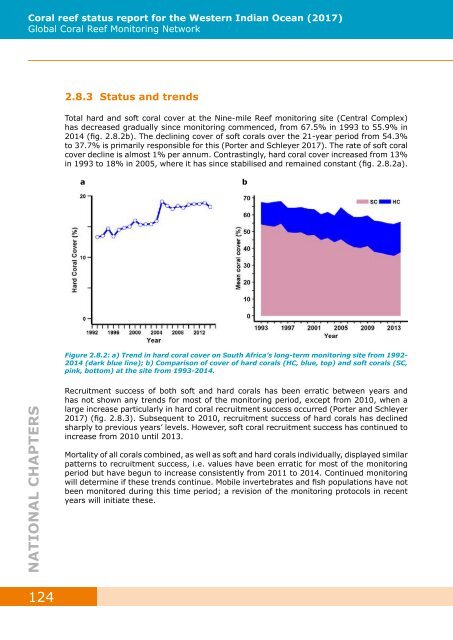GCRMN_COI_2017-Western Indian Ocean Reef Status
GCRMN Western Indian Ocean Coral Reef Status report for 2017. Produced by the Indian Ocean Commission and CORDIO East Africa
GCRMN Western Indian Ocean Coral Reef Status report for 2017. Produced by the Indian Ocean Commission and CORDIO East Africa
Create successful ePaper yourself
Turn your PDF publications into a flip-book with our unique Google optimized e-Paper software.
Coral reef status report for the <strong>Western</strong> <strong>Indian</strong> <strong>Ocean</strong> (<strong>2017</strong>)<br />
Global Coral <strong>Reef</strong> Monitoring Network<br />
2.8.3 <strong>Status</strong> and trends<br />
Total hard and soft coral cover at the Nine-mile <strong>Reef</strong> monitoring site (Central Complex)<br />
has decreased gradually since monitoring commenced, from 67.5% in 1993 to 55.9% in<br />
2014 (fig. 2.8.2b). The declining cover of soft corals over the 21-year period from 54.3%<br />
to 37.7% is primarily responsible for this (Porter and Schleyer <strong>2017</strong>). The rate of soft coral<br />
cover decline is almost 1% per annum. Contrastingly, hard coral cover increased from 13%<br />
in 1993 to 18% in 2005, where it has since stabilised and remained constant (fig. 2.8.2a).<br />
a<br />
b<br />
Figure 2.8.2: a) Trend in hard coral cover on South Africa’s long-term monitoring site from 1992-<br />
2014 (dark blue line); b) Comparison of cover of hard corals (HC, blue, top) and soft corals (SC,<br />
pink, bottom) at the site from 1993-2014.<br />
NATIONAL CHAPTERS<br />
Recruitment success of both soft and hard corals has been erratic between years and<br />
has not shown any trends for most of the monitoring period, except from 2010, when a<br />
large increase particularly in hard coral recruitment success occurred (Porter and Schleyer<br />
<strong>2017</strong>) (fig. 2.8.3). Subsequent to 2010, recruitment success of hard corals has declined<br />
sharply to previous years’ levels. However, soft coral recruitment success has continued to<br />
increase from 2010 until 2013.<br />
Mortality of all corals combined, as well as soft and hard corals individually, displayed similar<br />
patterns to recruitment success, i.e. values have been erratic for most of the monitoring<br />
period but have begun to increase consistently from 2011 to 2014. Continued monitoring<br />
will determine if these trends continue. Mobile invertebrates and fish populations have not<br />
been monitored during this time period; a revision of the monitoring protocols in recent<br />
years will initiate these.<br />
124


















